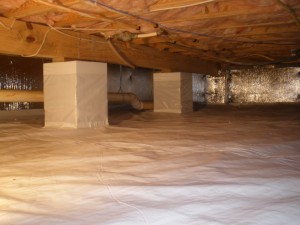 Crawlspace encapsulation was not always thought of as “necessary.”
Crawlspace encapsulation was not always thought of as “necessary.”
The school of thought for many years in the building community was to vent the crawlspace and keep the vents open in the summer and closed in the winter. Crawlspaces of the past were always vented. However, vented crawlspaces often had another thing in common: they were almost always wet.
Waterproofing contractors been laying plastic and adding drain tiles to dirt crawlspaces for years but the crawlspaces were still vented. They didn’t see the vents as the source of the moisture problems. It wasn’t until 2005 when the building codes started changing to make crawlspace encapsulation mainstream and a more common building practice.
Back in 2005, Advanced Energy a building science research firm took another approach. They were the building scientists behind researching the idea of closing the crawlspace, waterproofing it, insulating and conditioning the space as if it were part of the home. Their research changed the way contractors look at crawlspaces and started actually changing building codes to mandate closed crawlspaces.
While that took care of new construction there were still thousands of existing vented and dirt crawlspaces. Basement and crawlspace waterproofing contractors across the U.S. started doing retrofit jobs to encapsulate crawlspaces. Treating the crawlspace like it is part of the house is key. What is below the house definitely impacts the environment upstairs. It impacts indoor air as well as energy efficiency. A house is more energy efficient, comfortable and has better indoor air quality if the crawlspace is closed.
Some contractors use vent covers to close the vents while others replace the vent with a cinder block. Once they close the vents, they add a vapor barrier to the ground and the walls.
It is important to understand that just encapsulating the crawlspace will not make it dry. You have to deal with the water issue first. If you don’t, lining the crawlspace and closing the vents will only trap the water beneath the liner. You have to solve the water issues first and then close the crawlspace to ensure it stays dry.